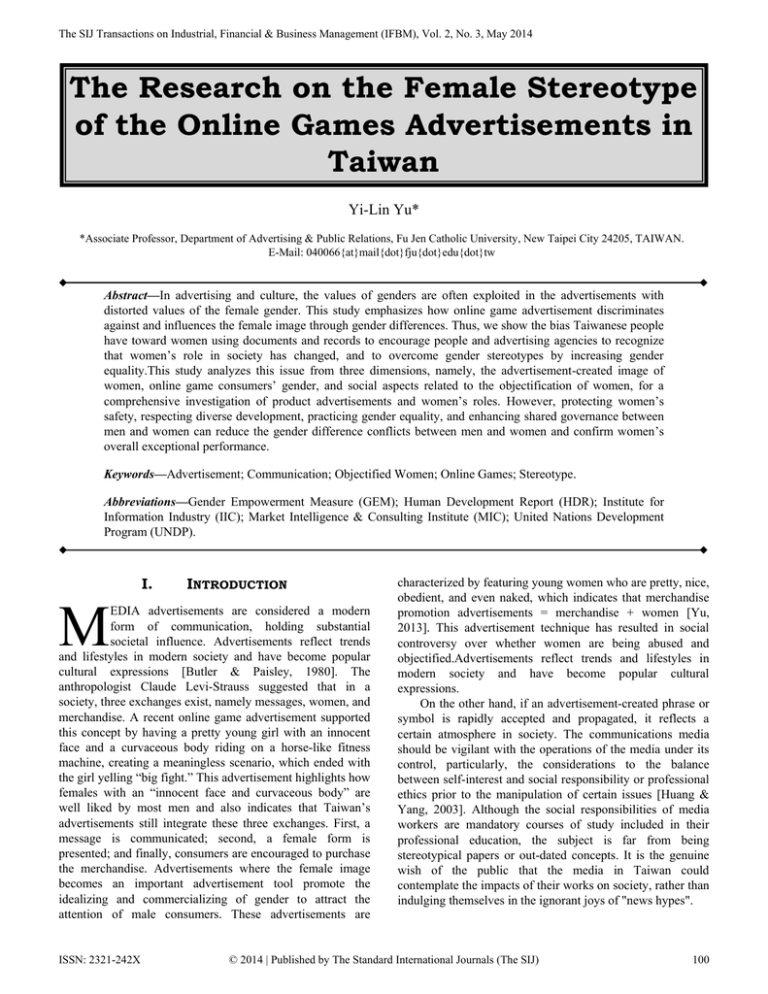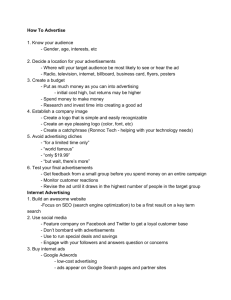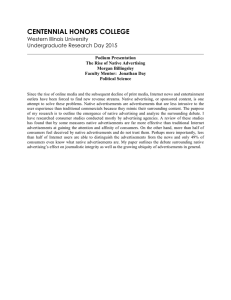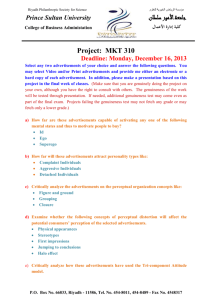Document 14544966
advertisement

The SIJ Transactions on Industrial, Financial & Business Management (IFBM), Vol. 2, No. 3, May 2014
The Research on the Female Stereotype
of the Online Games Advertisements in
Taiwan
Yi-Lin Yu*
*Associate Professor, Department of Advertising & Public Relations, Fu Jen Catholic University, New Taipei City 24205, TAIWAN.
E-Mail: 040066{at}mail{dot}fju{dot}edu{dot}tw
Abstract—In advertising and culture, the values of genders are often exploited in the advertisements with
distorted values of the female gender. This study emphasizes how online game advertisement discriminates
against and influences the female image through gender differences. Thus, we show the bias Taiwanese people
have toward women using documents and records to encourage people and advertising agencies to recognize
that women‘s role in society has changed, and to overcome gender stereotypes by increasing gender
equality.This study analyzes this issue from three dimensions, namely, the advertisement-created image of
women, online game consumers‘ gender, and social aspects related to the objectification of women, for a
comprehensive investigation of product advertisements and women‘s roles. However, protecting women‘s
safety, respecting diverse development, practicing gender equality, and enhancing shared governance between
men and women can reduce the gender difference conflicts between men and women and confirm women‘s
overall exceptional performance.
Keywords—Advertisement; Communication; Objectified Women; Online Games; Stereotype.
Abbreviations—Gender Empowerment Measure (GEM); Human Development Report (HDR); Institute for
Information Industry (IIC); Market Intelligence & Consulting Institute (MIC); United Nations Development
Program (UNDP).
I.
M
INTRODUCTION
EDIA advertisements are considered a modern
form of communication, holding substantial
societal influence. Advertisements reflect trends
and lifestyles in modern society and have become popular
cultural expressions [Butler & Paisley, 1980]. The
anthropologist Claude Levi-Strauss suggested that in a
society, three exchanges exist, namely messages, women, and
merchandise. A recent online game advertisement supported
this concept by having a pretty young girl with an innocent
face and a curvaceous body riding on a horse-like fitness
machine, creating a meaningless scenario, which ended with
the girl yelling ―big fight.‖ This advertisement highlights how
females with an ―innocent face and curvaceous body‖ are
well liked by most men and also indicates that Taiwan‘s
advertisements still integrate these three exchanges. First, a
message is communicated; second, a female form is
presented; and finally, consumers are encouraged to purchase
the merchandise. Advertisements where the female image
becomes an important advertisement tool promote the
idealizing and commercializing of gender to attract the
attention of male consumers. These advertisements are
ISSN: 2321-242X
characterized by featuring young women who are pretty, nice,
obedient, and even naked, which indicates that merchandise
promotion advertisements = merchandise + women [Yu,
2013]. This advertisement technique has resulted in social
controversy over whether women are being abused and
objectified.Advertisements reflect trends and lifestyles in
modern society and have become popular cultural
expressions.
On the other hand, if an advertisement-created phrase or
symbol is rapidly accepted and propagated, it reflects a
certain atmosphere in society. The communications media
should be vigilant with the operations of the media under its
control, particularly, the considerations to the balance
between self-interest and social responsibility or professional
ethics prior to the manipulation of certain issues [Huang &
Yang, 2003]. Although the social responsibilities of media
workers are mandatory courses of study included in their
professional education, the subject is far from being
stereotypical papers or out-dated concepts. It is the genuine
wish of the public that the media in Taiwan could
contemplate the impacts of their works on society, rather than
indulging themselves in the ignorant joys of "news hypes".
© 2014 | Published by The Standard International Journals (The SIJ)
100
The SIJ Transactions on Industrial, Financial & Business Management (IFBM), Vol. 2, No. 3, May 2014
Advertisements reflect the trends and lifestyle of modern
society and have become popular public cultural expressions.
As the Italian politician and philosopher Antonio Gramsci
stated, current social values, desires, and fears are always
present in idioms, proverbs, and folktales. This is the role of
an advertisement. If a phrase or symbol created by an
advertisement is rapidly accepted and propagated, it reflects a
certain atmosphere in that society [Adorno, 1997]. In other
words, the characteristics of an advertisement inevitably
communicate and create the culture; thus, if women are
objectified and stereotyped in an advertisement, although the
ideology and symbolism may appeal to the audience who
accept that image, it also reinforces the negative impressions,
objectification, and abuse. Therefore, to understand the
controversial effect of advertisements and documents, this
study provides an analysis on this issue from three
dimensions, that is, the image of women created by
advertisements, online game consumers‘ gender, and social
aspects relating to the objectification of women, for a
comprehensive investigation of product advertisements and
the role of women. We expect to propose some positive
strategies to equalize women‘s social position.
II.
REVIEW OF THE LITERATURE
In chapter two, the researcher reviewed related literature as
follows: the portrayal of women in advertisements, the
culture of women and consumption, the changing role of
women in advertisements, modern women cannot dominate
advertisement, gender issues related to online gaming,
appealing Online-Game to male player and how online games
influence female characteristics. For this study, the manner in
which gender stereotype was a central issue.
2.1. The Portrayal of Women in Advertisements
The influences of advertisement campaigns at present have
grown in complexity compared with its original purposes.
The advertisements have transformed into major drivers for
the distribution of information on consumer culture in the
society and long since deviated from its fundamental
objective: that of ―informing‖ the general public on product
information to create demand for the merchandise and thus
promoting the sales of the goods. In advertising and culture,
the values of genders are often exploited in the
advertisements with distorted values of the female gender.
The sheer quantities of advertisements and information in
contact with the public call for the need to develop the
abilities of ―media literacy‖ toward the advertisements.
American women‘s study scholar Tani E. Barlow
indicated from her research on women's issues in China
during the 1920‘s that, in order to comprehend the history of
the colonialism and modernism of the lifestyles during the
period, one shall derive an understanding from the copies and
graphic depictions of females in the commercial
advertisements (especially those funded by multinational
corporations) [Barlow, 2007]. She suggested that by
observing the images of females constructed in the
ISSN: 2321-242X
advertisements, the correlations between the image of the
product commercial and the common sociology collectively
create a specific social class ideology. The arguments
proposed by Barlow highlighted that the analysis of the
progressions of economy and society from the perspectives of
women's issues and needs may present the complete picture
of social progression, reformation and practice with
meticulous details. Traces of the roles and responsibilities of
women in the "modernization" process may be obtained from
the contents of advertisements. Because the gender roles
reinforced in advertisements have prompted studies, protests,
and an increase in feminist movements, a number of scholars
have contended that advertisements reflect social attitudes
and public perceptions. This belief has interested social
scholars, who have begun investigating and analyzing the
impact of current social values. Under traditional gender
roles, men are considered to work hard outside of the house
while women stay home and care for children and
housework. Additionally, traditional gender roles also specify
the personality traits that a women or man should possess.
This is promoted from the beginning in how parents treat
their babies, boys play with robots, guns, swords, cars, boats,
and airplanes, whereas girls play with dolls and
housekeeping.
Gender stereotypes are obtained by the continued
enforcements of the learning process, which allows us to
learn the skills required to interact with others and live
amongst the society. Due to the vast amount of information in
the surrounding environment, our general lack of critical
thinking towards the information subsequently leads to the
generation of stereotypes in our minds, which is then
exploited by the advertisements as interpretations of existing
cultural phenomenon [Beauvoir, 1972]. For social norms and
stereotypes of modern society, men and women are taught to
adopt different perspectives and personalities; men should be
tough and strong and women should be sweet and feminine,
and whereas men work hard to earn money for the household,
women stay at home and ensure that the family home is a
comforting place. However, after World War II, women
began to examine traditional gender roles. They pursued
financial independence, emphasized work and income
equality, and actively participated in public affairs and
politics. These efforts overcame long upheld gender biases,
patriarchal social norms, and the notion of patriarchy.
However, with the proliferation of mass media,
advertisements do not reflect this phenomenon, continuing to
portray gender stereotypes, which has lead to new problems
for men and women.
The impact of advertisements is not limited to media and
product promotion, but also to our society, economy, and
cultures, with different forms creating meaning and symbols,
broadly influencing the cognition, attitudes, affections, and
behavior of the public [Sutherland & Sylvester, 2000].
Advertisements widely advocate the new consumerist culture
of capitalism, using images that have substantial symbolic
significance for various product marketing strategies (e.g., a
friendly mother selling kitchen cleaning products, a pretty
© 2014 | Published by The Standard International Journals (The SIJ)
101
The SIJ Transactions on Industrial, Financial & Business Management (IFBM), Vol. 2, No. 3, May 2014
slim model endorsing slimming or fat-burning products, a
young-looking buxom star acting as the spokesperson for an
online game, and a beautiful celebrity with an attractive
figure endorsing cosmetic or bathing products). Drink
producers have also employed beautiful women to represent
their products. In a patriarchal society, advertisements
reinforced in the minds of consumers the concept that women
are a product. Thus, the value of women and the product is
equalized; women are portrayed with stereotypical
characteristics, and their appearance is used to undermine the
development of modern women. Is the company selling a
product or female stereotypes? Not restricting the use of
female stereotypes in advertisements is sexually
discriminating, insulting, and offensive to human dignity.
Advertisements have a substantial ability to educate
society and are one of the most helpful tools for affirming the
value and characteristics of modern women. Furthermore, no
excuses should be afforded to advertisers because they have a
responsibility to society. Therefore, based on these
inferences, this study discusses three different points of view,
we are going to describe as follows.
these advertisements are attempting to excite men‘s desire,
despite not explaining the product. They objectify women
through this product-selling interaction by selling the image
of a female body to men. These advertising agencies base
their marketing strategy on women‘s appearance for their
own benefit by commercializing the female form, which
negatively influences society in the long term.
Figure 1: Big Fight Online
[Source from: http://www.youtube.com/watch?v=hRLqrYVsUas]
2.2. The Culture of Women and Consumption
In this era of diversity, trends become cultures in everyday
life, including popular culture and subcultures with different
gender and age demographics. Everyone is inevitably
affected by trends, which have a significant influence on our
consumption.
The
current
commercialization
and
consumption behavior differs completely from that of the
past. Nowadays, consumers are not only concerned with the
production cost, but they also consider the intangible value
the product provides [Strinati, 2005]. In these conditions,
manufacturers must produce the best product to retain their
customers and attract new customers. Under this consumption
scenario, women have a vital impact on the culture of
spending. However, gender issues and gender roles have also
become a merchandising tactic used by the market. In 2009, a
gaming company developed an online game entitled ―Big
Fight Online‖ (Figure 1). The advertisement for this game
focused primarily on attracting an Internet community and
online game players. Immediately following its release, it
attracted suitable attention. The advertisement encouraged its
target audience to employ a search engine to search for the
product, which resulted in friends enthusiastically discussing
the product online. Furthermore, news of this success spread
widely, demonstrating the significant benefits of
communication in advertising.
Subsequently, the company‘s competitors immediately
imitated the advertisement, for example the Prophecy
Online‘s ―female worker‖ version (Figure 2), Advanced
Mahjong Online‘s ―you can look but do not touch‖ version
(Figure 3), and Curse Online‘s ―quickly dispel my curse‖
(Figure 4). These advertisements use images of female bodies
in the advertisement to attract consumers, further
emphasizing society‘s interest in women with young faces
and attractive bosoms, objectifying women, and
communicating messages of sex in advertisements. Overall,
ISSN: 2321-242X
Figure 2: Prophecy Online
[Source from: http://www.youtube.com/watch?v=nWKCkI7wy9s]
Figure 3: Mahjong Online
[Source from: http://www.youtube.com/watch?v=m10_WlTN2lU]
Figure 4: Curse Online
[Source from: http://www.youtube.com/watch?v=ubQeXeb19ak]
© 2014 | Published by The Standard International Journals (The SIJ)
102
The SIJ Transactions on Industrial, Financial & Business Management (IFBM), Vol. 2, No. 3, May 2014
2.3. The Changing Role of Women in Advertisements
How the media portrays gender norms is believed to reflect
society‘s expectations and, furthermore, affect public
perceptions. Therefore, if gender inequality exists in society,
the media reflects these beliefs through interaction or
identification. Under substantial media exposure, these biases
are fostered easily among the community, and the influence
on society increases. In addition to advertisements
influencing how culture develops in society, the showing of
independence, self-esteem, and beauty by modern women is
still affected by issues on gender psychology and a
traditionally patriarchal society; the objectification of women
and sexual discrimination remains. Advertisements vividly
emphasize gender roles, creating a unique image of women,
which reinforce female stereotypes in people‘s minds
[Tuchman, 1978].
Both oriental and occidental studies indicate that gender
beliefs and roles were established many years ago. Generally,
advertisements portray women as attractive, obedient, nonaggressive, emotional, well-mannered, well-educated, caring,
and considerate of relationships. Conversely, men are
portrayed as strong, aggressive, successful, rational, and able
to control their temper. These stereotypes are perpetuated by
our families, peers, teachers, and the media among children
as a definition of gender differences, indirectly creating a
biased image of women in a patriarchal society.
Regarding the development of female roles in
advertisements, the American sociologists Sexton &
Haberman (1974) stated that the image of women in
advertisements is very narrow, although the advertisements
attempt to portray working women, the jobs are always
traditional, such as in an insurance company, kitchen
supplements, cleaning products, food, etc. In advertisements,
women are typically depicted as people who appreciate or
enjoy the products, subtly reinforcing the role of women as
being subsidiary, considerate, and obedient. The feminist
intellectual Simone de Beauvoir (1972) highlighted that
―Reproductions of the world are the same in character as the
world itself. They are all the works of men. Men describe the
world from their male perspective and confuse this with the
truth‖. Researcher Wang (1991) highlighted that television
commercials in Taiwan cannot overcome gender biases and
sexual discrimination. Researcher Li (1990) also stated that
the content of commercial still has men in a leading role and
the women are always young and beautiful, whereas the men
are middle-aged and have status. The role of women in
commercials is always that of a housewife, not the role they
most often play in real life as competent women in the
workplace; instead, they are most often portrayed as
supporting their husbands. Nowadays, gender bias can still be
seen in commercials, which tend to emphasize the ways
women please men, denying the independent role of women.
2.4. Modern Women Cannot Dominate Advertisement
What is the real image of a woman? According to a survey
conducted by Business Weekly on ―Perceptions of Women‘s
ISSN: 2321-242X
Status in Taiwan,‖ 82% of women perform better than men in
the workplace. Furthermore, the traditional impression of
South Korean women is that they do not have a high social
status; however, in South Korea‘s current IT industry, Ms.
Kim HyeJeong is a female executive. In 2002, for the first
time in history, IBM promoted a Ms. Park Jung Hwa as the
company executive.
Considering the conditions worldwide, how do people
view the role of women? According to the 2003 Human
Development Report (HDR) released by the United Nations
Development Program (UNDP), the Gender Empowerment
Measure (GEM) ranks women in Taiwan in twenty-first place
in the world and top in Asia for Global Education Motivators.
Peter F. Drucker, renowned management consultant,
acknowledged that the value of women is paramount because
women are thoughtful, caring, and resilient enough to
influence
traditional
management
mechanisms
[CommonWealth magazine Editorial Department, 1998].
CommonWealth previously published an article in their
March 1999 issue, entitled, ―Different Types of Woman,‖
where they interviewed women employed in various fields,
such as a politician, congresswoman, pilot, executive, and
entrepreneur
[CommonWealth
Magazine
Editorial
Department, 1999]. CommonWealth summarized the
interviews they obtained with these outstanding women and
concluded that the characteristics of a successful woman are
confidence, self-belief, and a resilient belief. Simultaneously,
they also found that these women enjoyed communicating
with others and creating opportunities for themselves.
This demonstrated how women have become financially
independent and have expanded their consumption power,
resulting in more commercials featuring men endorsing
female products, with what women desire being their primary
consideration. This has also resulted in men being marketed
as ―nice guys‖ to further appeal to women. For example, the
―Carnation Gentle Aesthetics‖ (Figure 5) commercial
combined the personality and features of men and women. In
the commercial, the man is portrayed as a sweet gentleman
who is considerate, performs chores, and tidies, presenting a
good image and creating a positive impression among
women. However, when the man says the words ―I promise
her, today I will be especially nice to her,‖ the commercial
reverts back to previous gender stereotypes. The commercial
references the traditional situation of a man being nice to a
woman during her menstrual cycle.
Traditionally, men consider women to be vulnerable
during their menstrual cycles and require that a man to care
for them. The words ―I promise her‖ conveys the notion that
women are delicate, helpless, and incapable, and must be
cared for by a man, and that the man must play the role of a
guardian for the woman. In addition, the words ―I will be
especially nice to her‖ demonstrates male chauvinism
because women are always required to be nice to men,
whereas when men are occasionally nice to women, society
exaggerates the significance. Consider another commercial
by ―Sweet Agreement Gold Jewelry‖ (Figure 6); the content
insinuates that men must play a supportive role when
© 2014 | Published by The Standard International Journals (The SIJ)
103
The SIJ Transactions on Industrial, Financial & Business Management (IFBM), Vol. 2, No. 3, May 2014
courting women. The man has no plan and must create a
romantic atmosphere; thus, he chooses what the girl likes,
which is the best strategy. Conversely, women are passive in
relationships and always wait for men to reveal their feelings.
Figure 7: The Global Online Gaming Market
[Source: Institute for Information Industry (IIC) (MIC), 2008]
Figure 5: Carnation Gentle Aesthetics
[Source from: www.youtube.com/watch?v=W_DE_1g7054]
Figure 8: Online Game Preferences by Gender
[Source: IIC (MIC), 2008]
Figure 6: Sweet Agreement Gold Jewellery
[Source from: www.youtube.com/watch?v=DYBdszgx6hw]
2.5. Gender Issues Related to Online Gaming
According to an MIC research report published in 2008
regarding Internet use and the online market in the new
generation, in 2006, Taiwan‘s online gaming market grew by
16.6% and had revenue of 87.8 billion, by 2007, it had
expanded to 95.9 billion, as shown in figures 7 and 8
[Institute for Information Industry (IIC), 2008]. The main
reason for this market expansion and increase in online
leisure gaming is the emergence of the otaku economy, which
has made online Internet gaming widely popular and
increased the types of games available, from cute animals,
happy farms, social networks, trade unions, chatting, through
to customizing interfaces. This has enhanced the variety of
games and increased the consumers. Women have also found
some game entertaining, recognizing the fun they can have
using computers. Online gaming is no longer a world of only
violence, women who rarely played online game before can
now enjoy the multi-dimensional state of gaming.
ISSN: 2321-242X
Although the number of female players has increased
significantly, a study conducted in Taiwan indicated that
women‘s experience and motivation to participate in online
games differs. Women primarily consider themselves passive
and adopt a caring role in games [Lu, 2005]. This indicates
that gender differences affect consumer behavior and use and
purchase attitudes. Furthermore, the differences between
genders also result in differing motivations and needs. By
observing online game advertisements we can see this
phenomenon in society. Advertising agencies that discovered
this through market research have continued to characterize
online gamer as masculine. From the promotion of online
game to the sales, the images and voices used by advertising
agencies use are always female to attract male players. For
example, the Magic World Online game had the words ―slash
annoying players, save girls, play without spending money,‖
(Figure 9) a sentence full of suggestive meaning, which
caught the attention of numerous audiences, making them
want to learn more about the game. This demonstrates that
how society views women is portrayed in advertisements; the
women are given the characteristics men want. Without
investigating the objective of the ad, we can see that the
meaning is sexually discriminatory. This reveals that women
are still manipulated by men in society and economically.
© 2014 | Published by The Standard International Journals (The SIJ)
104
The SIJ Transactions on Industrial, Financial & Business Management (IFBM), Vol. 2, No. 3, May 2014
Figure 9: Magic World Online
[Source from: http://www.youtube.com/watch?v=rj_IVyXAhr0]
Since 2007, these types of advertisements have been
widespread, leading us to wonder ―is this how stereotypes are
created in society?‖ Do companies attempting to promote
their product use idealized concepts to attract men player
through images of women? These social issues required longterm investigation. However, based on our previous findings,
we can elaborate further on the two different facts.
2.6. Appealing Online-Game to Male Player
Based on statistics published by the Ministry of
Transportation and Communication Department regarding the
Taiwan‘s online gamers, there are twice as many male
players compared to female players (aged 11 to 34 is 81.9%;
aged 15 to 24 is the peak point) [Department of Statistics,
Ministry of Transportation and Communications, 2005].
During the development stage of a game, most developers
consider the target audience to be male and, because they
want to attract male players, they use females as bait. Female
players in games mostly wear bikinis, which is indicative of
how men want to see women, denying women the right to
control their body. Recently, the online-game Big Fight
Online made headlines for the unforgettable quote ―big
fight,‖ which became a the most popular phrase in 2009.
The game was endorsed by Yiao-Yiao, a woman with a
young face, attractive bosom, and a baby voice, making her
popular in the media and on Internet forums and creating a
trend for this type of woman. The commercial was seen by
millions of people on YouTube and shocked the National
Communications Commission to become involved with this
social issue. To encourage audiences to get online and play
the game, the developers commented ―Big Fight Online, fight
ISSN: 2321-242X
monsters! All men smile!‖ on their website. In this statement
there are words that imply sex, such as ―It turns out that the
secret weapon for making men smile is ‗lace equipment‘ –
red, white, black, and leopard-print lace underwear, shorts
that show off rear ends, and the appearance of heroines who
fight monsters is simply a benefit of another type of pressure
test!‖
From a media perspective, considering current television
programs, advertisements, packaging, and news reports, we
can see that Yiao-Yiao has the ideal characteristics for men,
that is, she has attractive bosoms and is young, innocent, and
harmless. Yiao-Yiao‘s image was placed on numerous
product as if to convey ―purchase the product and you will
have me,‖ communicating seductive messages to consumers
and also cheapening the status of woman. However, more
appallingly, an online game company created an event called
―age 18 pictures,‖ where players photographed scantily
dressed women posing sexily, communicating strong
messages of sex and seduction, and then selected as the
winner a picture where the women was completed naked. The
online game company gave prizes to all the participants who
contributed to this outrageous phenomenon.
The media and advertising agencies tend to use images
of women with exaggerated features to attract specific
consumers, communicating inappropriate messages and
reinforcing unrealistic images of woman, which can
inadvertently lead people to develop the wrong logic. Some
people read and believe whatever the media publishes; it is
among these people that this phenomenon is happening.
These advertisements will reinforce stereotypes much more
deeply. Online game companies have successfully used this
type of negative communication to launch and create a buzz
in society surrounding a product; however, the social issues
they highlight to promote their event or product can also have
devastating consequence. Therefore, online game companies,
as well as advertising agencies, must take responsibility for
this problem.
2.7. How Online Games Influence Female Characteristics
Online gaming has increased significantly since the
emergence of the otaku economy. Online games have become
a tool for leisure similar to films, books, and music. In online
games, all the players are participants, by playing the game,
they can satisfy their desires and achieve fulfillment in the
virtual world, encouraging others to also participate in the
game. In other words, games can transport a person to
another world where they can be a different person. Through
special communication, reality can be brought into the virtual
online world, creating a new way of interaction [Steuer,
1992]. By observing online gamer, we found that most men
believe women cannot play online games, know how to
perform a penalty kick, have slow reactions, and is not
capable of pressing complex key sequences rapidly when
playing games. These perceptions reflect the way women are
portrayed as incompetent, dependent, and unable to
accomplish complex or challenging tasks.
© 2014 | Published by The Standard International Journals (The SIJ)
105
The SIJ Transactions on Industrial, Financial & Business Management (IFBM), Vol. 2, No. 3, May 2014
Most online gamer describe female gamers as weak,
requiring care, poor at resolving technical problems, have
trouble operating machinery, and cannot perform to the same
standard as a man. We can possibly explain this perception as
the result of men being unable to accept that women can be
similar to them or even better than them because of the male
ego [Chang, 2004]. Although gender should be equal in the
online gaming world, a researcher Lu (2005) discovered that
more interaction between genders in the virtual world
actually increased more biases between sexes. Women tend
to become weak and easily manipulated by men in the online
gaming world. The competitive online gaming world and
community tends to lack actual interaction with women.
Because their relationships with women in the virtual world
are influenced by their core differences on the Internet,
women have a hard time being accepted. The reinforced
gender differences and characteristics present in the online
gaming environment reveal that it is a patriarchal society,
where women‘s roles in games are similar to a vassal, with no
status.
In summary, the negative influences of the online
gaming world may be detrimental the portrayal of woman,
enhancing social gender inequality, also exposing society to
dangerous phenomenon. Therefore, the government and the
public should address the negative influences these
advertisements have had on society and make an effort to
combat them.
III.
CONCLUSION AND SUGGESTIONS
The levels of education, public health, infrastructure,
business development in Taiwan are relatively advanced, but
these do not equate with the ―modernization‖ of women‘s
circumstances in the country. The rise in the awareness of
feminism in recent years with equal opportunities for
education has provided significant space for development by
females to break off the shackles of traditional customs.
Combined with the characteristics such as delicacy and
patience typically lacking in males, the proportion of female
leaders in the management level in all types of careers in the
society has not only increased gradually, but significantly
rocketed in recent years [Yu, 2013]. How the genders are
portrayed in advertisements did not change according to how
gender roles actually changed in society, instead, they
continue to reinforce gender biases. Media has been also
continued to reinforce female stereotypes, patriarchal society,
and hegemony values [Liesbet, 2001].
The Big Fight Online incident, which was directly
sexually discriminatory toward women, has had a significant
impact on society, forcing people to examine gender issues in
today‘s world, messages in commercials, and recognize that
the information we receive from the media may not always be
correct and fair, and can lead to misunderstandings and
biases. To improve these problems, we provide the following
suggestions:
Cultivate media explanation capability—Consumers
receive dozens of advertisements messages daily; thus,
ISSN: 2321-242X
they must have the ability to evaluate the content. We
can use the power of the media to encourage consumers
to consider the information before judging what they see
or hear from advertisements.
Start from education—Because advertisements can
reflect current issues and social trends, people should be
educate regarding genders stereotypes from kindergarten
to ensure families and schools convey the right attitudes,
demonstrating the equal rights of women in society. The
public should actively promote gender equality
education. Through the method of ―education,‖ we hope
that both genders can stand on the same and equal
ground to develop their potential without restrictions
because of physiological, psychological, social, and
cultural gender factors. In promoting equal opportunities
for men and women within society, we can establish a
harmonious and diverse society based on the principle of
gender equality and reciprocal assistance.
Encourage feminism—The roles of females in the
society have grown in significance in the times where
education is widely available to the public with booming
economy and rising awareness for the females. Being the
latest theory on gender relations, "gender equality‖
allows the new gender relations to complement each
other with one‘s strengths as well as communication and
mutual respect for the other; both genders shall behave
with mutual respect and understanding and strive for
self-improvement to grow together. The gender
stereotypes inherent in the society shall be discarded to
return the balance between the genders. Men can display
the personalities of dependency or weakness whilst
women can be courageous or gentle to create harmonious
combinations of male and female roles rather than
focusing on the fight for absolute equality between men
and women. By fostering feminist movements, we hope
woman‘s social status will increase and the image of
women advertisements communicate will be modern and
fair. The rise of feminism brings heightened social
awareness and a new empowerment. Advertising
agencies should use this in their marketing strategies to
target new audiences subtly.
Media Responsibility to the Society—The media should
be careful of how they convey their messages to society,
how they portray issues, and the social responsibility
they have to society.
Everyone in the media industry would have learned in
school the responsibility the media has to society; therefore,
beyond accepting this concept theoretically, they should take
action in real life and not create issues merely to gain
popularity and forgetting the responsibility they have to the
public. Overall, the Council for Economic Planning and
Development, Taiwan, estimated that the female population
in Taiwan will exceed half the total population in 2014. The
life expectancy for women increased from 78.93 years in
1998 to 82.01 years in 2008. In addition, the female
enrollment rate and employment rate surpassed those of men.
These figures show that women have played an increasingly
© 2014 | Published by The Standard International Journals (The SIJ)
106
The SIJ Transactions on Industrial, Financial & Business Management (IFBM), Vol. 2, No. 3, May 2014
crucial role in the social development of Taiwan. However,
because of historical and cultural factors, habitual job
classification based on gender has not thoroughly considered
the requirements of women over the long-term. This not only
limits the development of females but also hinders the
progress and innovation of society. Therefore, protecting
women‘s safety, respecting diverse development, practicing
gender equality, and enhancing shared governance between
men and women can reduce the gender difference conflicts
between men and women and confirm women‘s overall
exceptional performance. We wish that in the future sexual
discrimination and gender issues will decrease and more
positive images of women will be reinforced, making the
world a better place.
REFERENCES
[1]
[2]
[3]
[4]
[5]
[6]
[7]
[8]
[9]
S. Beauvoir (1972), ―The Second Sex‖, London: Penguin.
D. Sexton & P. Haberman (1974), ―Women in Magazine
Advertisements‖, Journal of Advertising Research, Vol. 14, Pp.
41–46.
G. Tuchman (1978), ―Hearth and Home: Images of Women in
the Mass Media‖, N.Y: Oxford University Press.
M. Butler & W. Paisley (1980), ―Women and Mass Media:
Resource Book for Research and Action‖, New York: Hasting
House.
M.N. Li (1990), ―The Role of Women in Newspaper
Advertising – Examining Advertising in the United Daily News
from 1960 to 1989‖, Master’s Thesis, Fu Jen Catholic
University, Taipei, Taiwan.
X.Y. Wang (1991), ―The Analysis of Gender Roles in TV Ads
(Master Essay)‖, National Chengchi University, Taipei,
Taiwan.
J. Steuer (1992), ―Defining Virtual Reality: Dimensions
Determining Telepresence‖. Journal of Communication, Vol.
42, No. 4, Pp. 73–93.
T.W. Adorno (1997), ―Aesthetic Theory (Wang, K. P. Trans.)‖,
Sichuan People’s Publishing House, Chengdu.
CommonWealth magazine Editorial Department (1998),
―Different Types of Women‖, Taipei: CommonWealth
Magazine (March).
[10]
[11]
[12]
[13]
[14]
[15]
[16]
[17]
[18]
[19]
[20]
CommonWealth Magazine Editorial Department (1999),
―Different Types of woman‖, Taipei: CommonWealth
Magazine Group (March).
M. Sutherland & A. Sylvester (2000), ―Advertising and the
Mind of the Consumer‖, Australia: Allen & Unwin, St
Leonards.
V.Z. Liesbet (2001), ―Feminist Media Studies‖, Editors: C.H.
Chang & Liu, L. M.Trans. Taipei: Yuan-Liou Publishing Co.
Ltd.
H.C. Huang & S.C. Yang (2003), ―New Gender Imbalance‖,
Business Weekly e-Newsletter (November 10).
H.C. Chang (2004), ―Player Types in Online Role-Playing
Games‖, Master’s Thesis, Chinese Culture University, Taipei,
Taiwan.
Department of Statistics, Ministry of Transportation and
Communications (2005), ―Taiwanese Internet Usage Survey
Analysis‖,
Accessed
October
24,
2005
from
http://www.motc.gov.tw.service.
Y.W. Lu (2005), ―Investigating Internet Female Identity and
Cross-Gender Interaction in Multiplayer Online Role-Playing
Games‖, Master’s Thesis, Hsuan Chuang University, Hsinchu,
Taiwan.
D. Strinati (2005), ―Popular Communications Theory‖, Taipei:
Weber.
T.E. Barlow (2007), ―In Demand: The Natural Sciences, Social
Sciences and Women in the 1920s‖, Editors: Chien-Ming, Yu,
Mei-Chun, Luo, Ming, Shih, Chinese Women in the Republican
Era, Pp. 205–254. Taipei: Rivegauche.
Institute for Information Industry (IIC) (2008), ―Internet
Entertainment Behavior and Market Opportunities in the New
Era‖, Taiwan: Taipei.
Y.L. Yu (2013), ―The Impact of Women‘s Roles in Game
Advertisements: A Case Study of Online Game Advertisements
in Taiwan‖, Asia-Pacific Conference on Business & Social
Sciences, Pp. 241–253.
Yi-Lin Yu earned a PhD degree and two
Master degrees in USA with a focus on both
the mass communication and media
management field. He received many awards
in the field of digital design while in USA. He
is an expert in video game strategies, visual
communication, advertisements, marketing,
animation, and now serves as an associate
professor at FU-JEN Catholic University in
Taiwan.
ISSN: 2321-242X
© 2014 | Published by The Standard International Journals (The SIJ)
107





